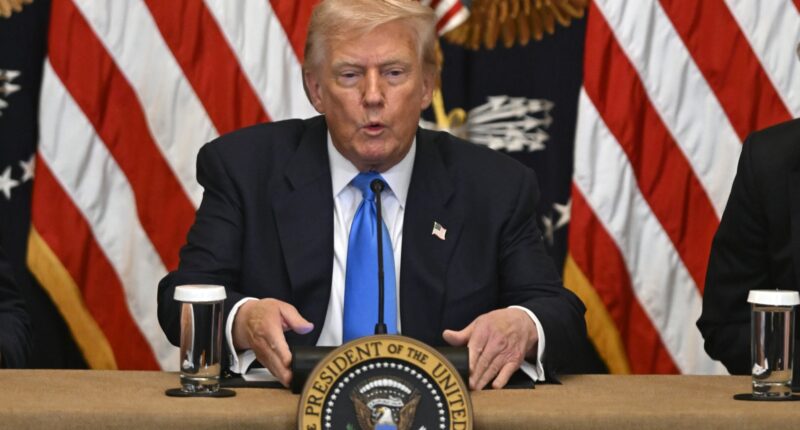Share this @internewscast.com
WASHINGTON — President Donald Trump on Thursday signed an executive order imposing new tariffs on several U.S. trade partners, set to take effect on Aug. 7—marking a key phase in his trade strategy that will challenge global economics and test U.S. alliances that have been established for years.
This order was issued soon after 7 p.m. on Thursday evening, following a burst of tariff-related announcements days prior. The administration disclosed deals with various countries and trade blocs, aligning with the president’s self-imposed Friday deadline. The tariffs are scheduled later to coordinate rate implementation, as stated by a senior administration official speaking anonymously to reporters.
Initially, the African nation of Lesotho faced a 50% tariff threat, but its goods will now be subjected to a 15% tariff. Taiwan will face a 20% tariff, Pakistan 19%, while countries like Israel, Iceland, Fiji, Ghana, Guyana, and Ecuador will also see their imported goods taxed at 15%.
The order concluded a busy Thursday of nations trying to continue negotiations with Trump. It established tariff rates for 68 countries and the 27-member European Union, instituting a 10% baseline rate for countries not specified in the order. According to a senior administration official, these rates were determined by trade imbalances with the U.S. and regional economic characteristics.
On Thursday morning, Trump had a phone conversation with Mexican President Claudia Sheinbaum discussing trade. Following the discussion, the U.S. president agreed to a 90-day negotiation period with Mexico, a major trade partner, maintaining the current 25% tariff rate rather than elevating it to the previously threatened 30%.
“We prevented the tariff hike planned for tomorrow and secured 90 days to negotiate a long-term deal through dialogue,” Mexican President Claudia Sheinbaum wrote on X, after what Trump described as a “very successful” call that helped the leaders understand each other better.
The unknowns created a sense of drama that has defined Trump’s rollout of tariffs over several months, with the one consistency being his desire to levy the import taxes that most economists say will ultimately be borne to some degree by U.S. consumers and businesses.
“We have made a few deals today that are excellent deals for the country,” Trump told reporters on Thursday afternoon without detailing the terms of those agreements or nations involved. The senior administration official declined to reveal the nations that have new deals during the call with reporters.
Trump said that Canadian Prime Minister Mark Carney had called ahead of 35% tariffs being imposed on many of his nation’s goods, but “we haven’t spoken to Canada today.”
Trump imposed the Friday deadline after his previous “Liberation Day” tariffs in April resulted in a stock market panic. His unusually high tariff rates unveiled in April led to recession fears, prompting Trump to impose a 90-day negotiating period. When he was unable to create enough trade deals with other countries, he extended the timeline and sent out letters to world leaders that simply listed rates, prompting a slew of hasty deals.
Trump reached a deal with South Korea on Wednesday, and earlier with the European Union, Japan, Indonesia and the Philippines. His commerce secretary, Howard Lutnick, said on Fox News Channel’s “Hannity” that there were agreements with Cambodia and Thailand after they had agreed to a ceasefire to their border conflict.
Going into Thursday, wealthy Switzerland and Norway were still uncertain about their tariff rates. EU officials were waiting to complete a crucial document outlining how the framework to tax imported autos and other goods from the 27-member state bloc would operate. Trump had announced a deal Sunday while he was in Scotland.
Trump said as part of the agreement with Mexico that goods imported into the U.S. would continue to face a 25% tariff that he has ostensibly linked to fentanyl trafficking. He said autos would face a 25% tariff, while copper, aluminum and steel would be taxed at 50% during the negotiating period.
He said Mexico would end its “Non Tariff Trade Barriers,” but he didn’t provide specifics.
Some goods continue to be protected from the tariffs by the 2020 U.S.-Mexico-Canada Agreement, or USMCA, which Trump negotiated during his first term.
But Trump appeared to have soured on that deal, which is up for renegotiation next year. One of his first significant moves as president was to impose tariffs on goods from both Mexico and Canada earlier this year.
U.S. Census Bureau figures show that the U.S. ran a $171.5 billion trade imbalance with Mexico last year. That means the U.S. bought more goods from Mexico than it sold to the country.
The imbalance with Mexico has grown in the aftermath of the USMCA, as it was only $63.3 billion in 2016, the year before Trump started his first term in office.
Associated Press writers Lorne Cook in Brussels and Jamey Keaten in Geneva contributed to this report.
Copyright © 2025 by The Associated Press. All Rights Reserved.

















